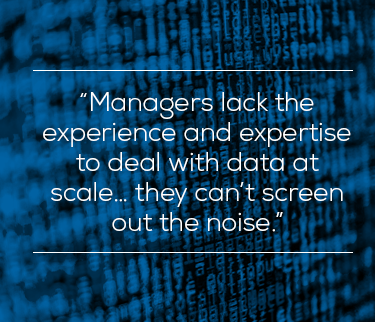More than 150 years ago, the pioneer of computerization, Charles Babbage, recognised a crucial truth: machines given incorrect information will provide incorrect answers.
“Garbage in, garbage out”, as this concept is sometimes known.
It’s an idea with which many asset managers are all too familiar: while they recognize the need to generate more actionable insight from ever-increasing data volumes, they’re not always confident in that data. There are plenty of reasons why errors may occur in the accounting data coming from the back office, in the data coming from third parties, and in the calculations made by the performance system itself.
The result is that performance measurement systems fail to deliver because all too often they don’t provide meaningful outputs that stand up to attention, or function as useful inputs for further analysis. Ultimately, asset managers who don’t trust their data may ignore the insight it generates – even when the information is reliable.
{{cta(‘bcdd0f82-15ab-4a31-97d7-953aaeb085d7′,’justifyleft’)}}
Here we look at five common reasons why poor data control is possibly the biggest challenge for the asset management industry today.
 Problem 1: Data requires significant processing
Problem 1: Data requires significant processing
Data coming in from a multitude of sources will have been collected for various purposes using a range of different methods. Asset managers then have to devote considerable resources to processing and scrubbing this data so that it is fit for purpose.
The solution: Look for a performance measurement system with a robust data import model and one that comes complete with market data. Centralizing this data and reducing the number of external sources reduces the operational risk to the data itself. In other words, aim to reduce data sources and manual interventions to a minimum.
Problem 2: Data is presented in non-compatible formats
With no industry-wide standards for data interchange, information flows up and down the asset management value chain in all different formats that clash and contradict one another. Asset managers then have to find ways to reconcile this data.
The solution: There is no magic silver bullet that is going to solve this issue overnight. Nevertheless, having a platform that centralizes performance, market, risk and analytics data in one place certainly helps reduce the amount of consolidation tasks that have to take place before final reports can be delivered to stakeholders.
Problem 3: There is so much data, identifying the useful information is too difficult
The sheer scale of data now flowing into asset managers’ performance measurement systems is unprecedented. But managers lack the experience and expertise to deal with data at scale and therefore find it very difficult to pinpoint the information that is valuable. They can’t screen out the noise.
The solution: Look for a performance measurement solution that provides a visual and intuitive workflow. Working with data at scale requires visualization. Managers need the ability to drill down and fix issues in specific portfolios without holding up the entire process. Having a single platform for both performance and risk also consolidates data management tasks.
Problem 4: Data flows in via user interfaces that are difficult to understand
Performance measurement systems depend on user interfaces that enable asset managers to quickly extract the specific results they need from their data. However, all too often these interfaces are poorly designed or lack functionality, making it much more difficult for asset managers to capture the insights required.
The solution: Look for a performance measurement system with simple-to-use data interfaces that provide visual cues and alerts that make it easier to extract key insights or highlight problems quickly. Such interfaces should be configurable so that asset managers can focus on what is most relevant to their business.
Problem 5: Data is incorrect
Of course the worst case is when the data that asset managers receive is simply incorrect. In one recent research study conducted by the Economist Intelligence Unit, one in five asset managers said incorrect data is one of the biggest challenges they face.
The solution: Look for a performance measurement system with functionality that validates the accuracy of source data through a variety of configurable data control checks and balances, including reconciliations, data-quality checks and resolution of discrepancies.
Look to the future
For any asset manager, the commitment to eliminating data errors from the performance measurement process is a serious undertaking. But as Arthur Nielsen, Founder of AC Nielsen once said: “The price of light is less than the cost of darkness.”
The bottom line is that the output of no performance measurement system can be relied on if it is operating on incorrect or incomplete data. Basic data errors undermine asset managers’ ability to generate meaningful insights and will restrict their promise of adding value for clients.
Takeaways
- Asset managers must turn source data into actionable insight using performance measurement systems built on reliability, consistency and usability.
- Data flows into asset managers from multiple sources: it must be translated and integrated into “one version of the truth” used by performance measurement systems and downstream analytics including risk.
- Asset managers need to eliminate costly manual processes and need a performance measurement system with the functionality and intelligence to achieve this.
- Asset managers need systems that deliver insight in user-friendly formats that are simple and convenient for all users.
- Middle offices that fail to eliminate performance measurement errors and inconsistencies will lose the confidence of stakeholders and, ultimately, clients.
{{cta(‘fa3b4f0d-4c30-4f05-8a1f-f9f2febb3edb’)}}
